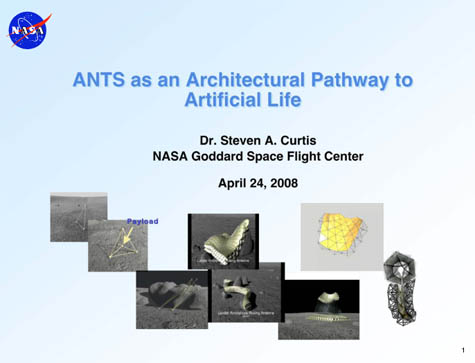 [Image: NASA’s ANTS].
[Image: NASA’s ANTS].
Alex Trevi sent me a link last week – which he later posted – about the so-called ANTS program. ANTS is an “autonomous nano technology swarm” developed by NASA for possible use in the “lunar base infrastructure” of tomorrow.
ANTS consist of “highly reconfigurable networks of struts, acting as 3D mesh or 2D fabric to perform a range of functions on demand.”
The ANTS approach harnesses the effective skeletal/muscular system of the frame itself to enable amoeboid movement, effectively ‘flowing’ between morphological forms. ANTS structures would thus be capable of forming an entire mobile modular infrastructure adapted to its environment.
However, I was especially excited to see that the ANTS system has been hypothesized as “an architectural pathway to artificial life.”
Might the artificial biology of tomorrow be buildings that have come to life?
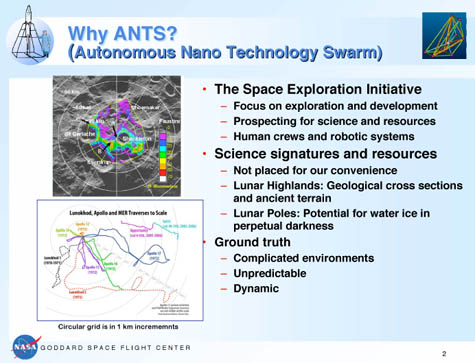
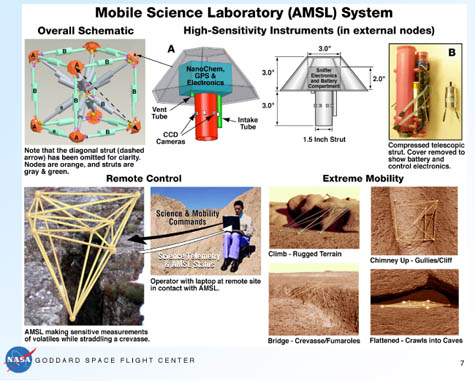 [Images: NASA’s ANTS].
[Images: NASA’s ANTS].
I’m reminded here of Philip Beesley’s Implant Matrix, or Theo Jansen’s Strandbeesten, machine-architectures that cross over into animation and back, convincingly evincing signs of life.
But NASA’s recent research into ANTS suggests that these units could actually be used to build whole bases and instant cities under extreme – and literally lunar – living conditions, where the village itself would not be just a substrate or infrastructure but a kind of artificially intelligent labyrinth of living architecture that coils round itself in a cascade of walls and air locks. All under the constant radiative glare of the sun.
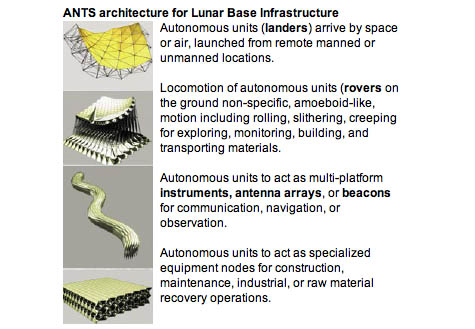 [Image: NASA’s ANTS].
[Image: NASA’s ANTS].
These “autonomous remote systems,” as NASA refers to them, are already coming into existence, of course; one need only look as far as the skies of the Middle East, for instance, which now buzz with unmanned aerial drones, or at the deep desert labs of the U.S. Air Force, where shape-shifting airplanes are taking (and re-taking) shape.
But is there a drone architecture?
Unmanned buildings – server farms, parking garages, airport terminals, and offshore cargo-processing warehouses (or RoboVault, say) – that, given mobility, could approach the condition of biology?
And is this what the haunted house genre has always been about: a fear of architecture that has come to life?
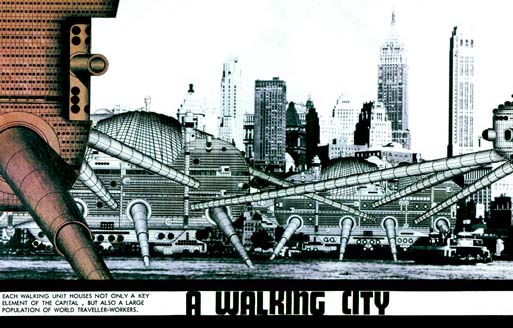 [Image: Ron Herron’s Walking City, first proposed in Archigram 4 (1964)].
[Image: Ron Herron’s Walking City, first proposed in Archigram 4 (1964)].
It’s NASA meets Archigram meets Manuel de Landa meets Theo Jansen – a walking city gone off-world, communicating via secure satellite to earthbound observers back home.
(See also Pruned‘s take on this).
Right up my alley: artificial life, lunar colonisation, fluid architecture, and an Archigram reference to boot. But my first reaction was of complete and utter dread. I imagine the colony-mind of these ANTS reaching some critical threshold of intelligence. Becoming an artificial lifeform whose corporeal body is literally the (autonomously adjustable) barrier between you and the atmosphere-less, solar radiated surface of the moon. Not a new thought to be sure (cf. HAL &c), but a scary one nevertheless.
I agree, bean. Kind of a “this can’t be good” feeling.
Also, I wonder if NASA meant architecture when they said architecture. After all, we now have data architecture and many other neologisms. Were they talking specifically about buildings, or was this more strategic?
Wow, once upon a time if you didn’t like your house or town, you could up and leave. Soon if your place doesn’t like you, IT can leave!Imagine coming home to no home and finding a terse message about not being able to stand your bad habits anymore…
see also R&Sie(n) works
explore
http://www.new-territories.com
This comment has been removed by the author.
(Confusing typo in my first post of this… sorry)
@Bean, exurban
What’s so scary about a lifeform whose “corporeal body is literally the barrier between you and the atmosphere-less, solar radiated surface of the moon”? Is my corporeal body not literally the barrier between me and you? Additionally, I don’t see the connection between ANTS and HAL. Do you mean that non-fiction artificial intelligences are equally likely to be malevolent as fictional A.I.’s? This fear, shared by many, seems like nothing more than anthropomorphism to me. To borrow a point from J. Storrs Hall, the idea that a diahuman machine intelligence would be an intrinsic threat to our existence is based largely on our own tribalism. There’s little evidence outside of science-fiction to suggest the validity of a “hard-takeoff” scenario in which A.I. is naturally hellbent on crushing human life.
While on colony minds, critical thresholds of intelligence (what does this mean?), and negative sci-fi scenarios, I am reminded of Orson Scott Card’s buggers. If you’ll recall, the primary cause of war between humanity and the buggers was the “murder” of a number of humans on a mining outpost. This illustrates what I say about anthropomorphism and what Hall says about tribalism; in Card’s story, the humans are guilty of making the assumption that the bugger action was comparable to murder. To the buggers this would have been a totally insignificant blip of pain out on the far edges of consciousness, like clipping one’s fingernails. Humanity responded as if threatened by a rival tribe and destroyed their village – in this case the bugger homeworld. It took the brightest and most compassionate envoy of humanity to not only destroy them but to learn to communicate with them.
So my question to you is, why wouldn’t we be able to communicate with the ANTS? Can you imagine having such a body? It would be WONDERFUL! All the power you needed harvested directly from the solar-radiated surface of the Moon, the ability to change yourself to suit your needs… someone please load my mind-file into THAT body! Wouldn’t you be grateful to the intelligent beings who created you? I suppose I would be immensely troubled by their incessant squabbling and weird tribal mind, but I think that being a hell of a lot smarter than them might motivate me to help, not to destroy. Surely this is a simple, sanguine view of a narrow range of possibilities, but I firmly believe that it is much better to approach these questions from an optimistic position than to assume the worst case scenario.
Back in 1980 NASA did an exhaustive study of what it would take to make an autonomous self-replicating lunar factory. This ANTS thing would be the perfect housing for such an endeavor. Take a look at http://www.islandone.org/MMSG/aasm/
It’s really inspiring stuff. Pave the moon!
hello, ANTS project is very interesting, I like it!
look at the other one http://www.symbrion.org/
or look at my own 3 years old concept for buildings http://artificialsymbiont.blogspot.com/
claytronics
to be a little more specific: CATOMS is being currently developed by Carnegie Mellon’s University scientists, thanks to heavy funding by Intel and the DARPA
http://www.cs.cmu.edu/~claytronics/
http://en.wikipedia.org/wiki/Claytronics
http://techiteasy.org/2007/02/16/303/